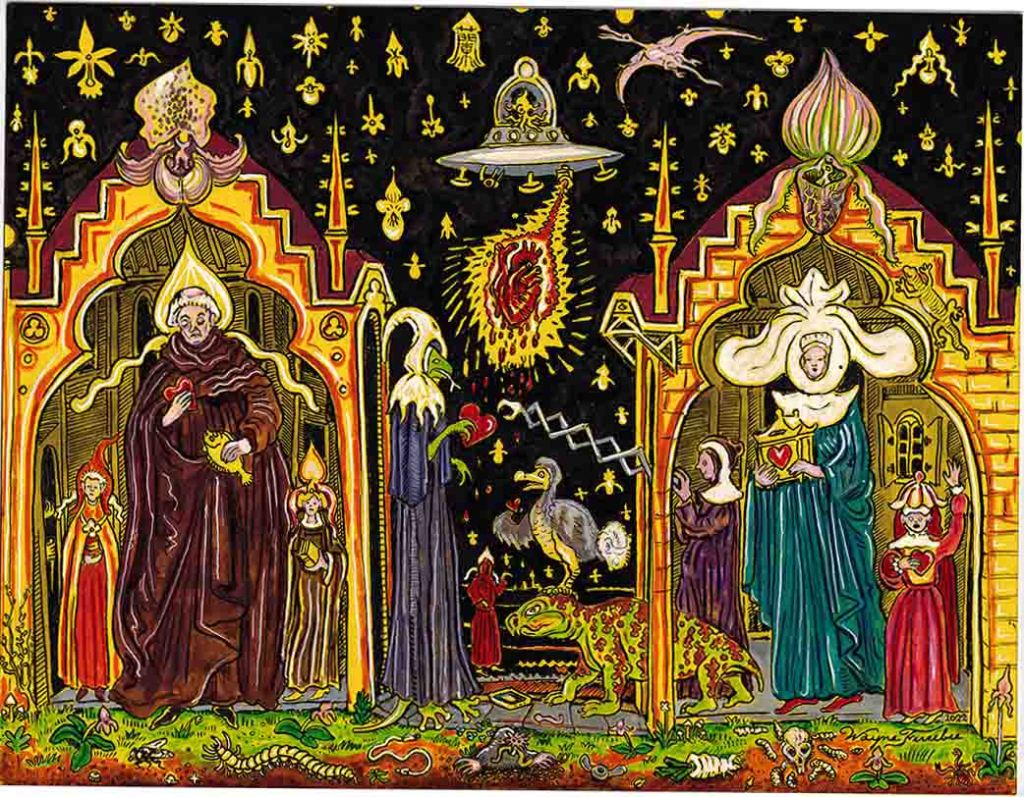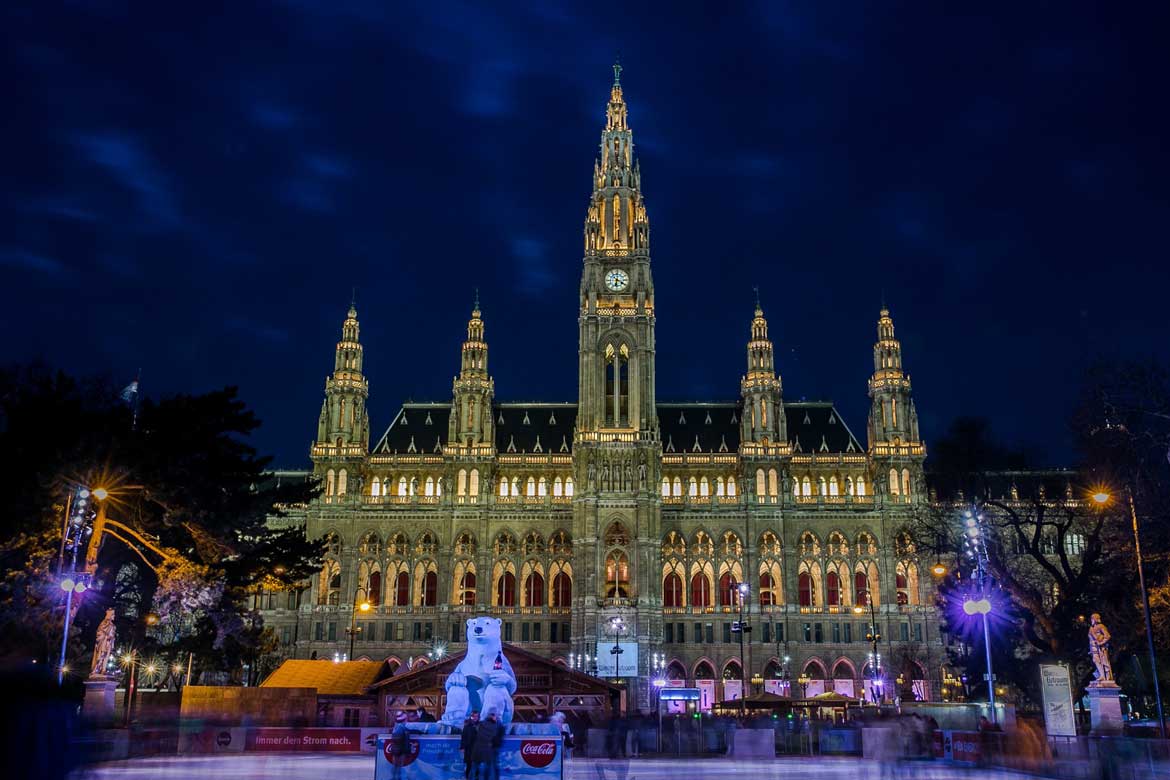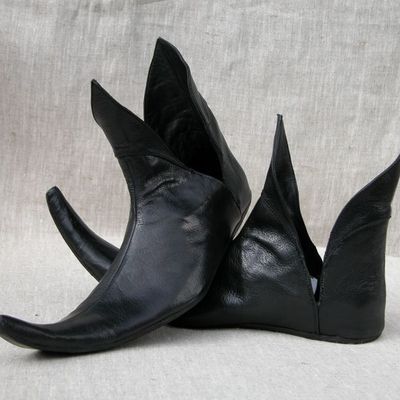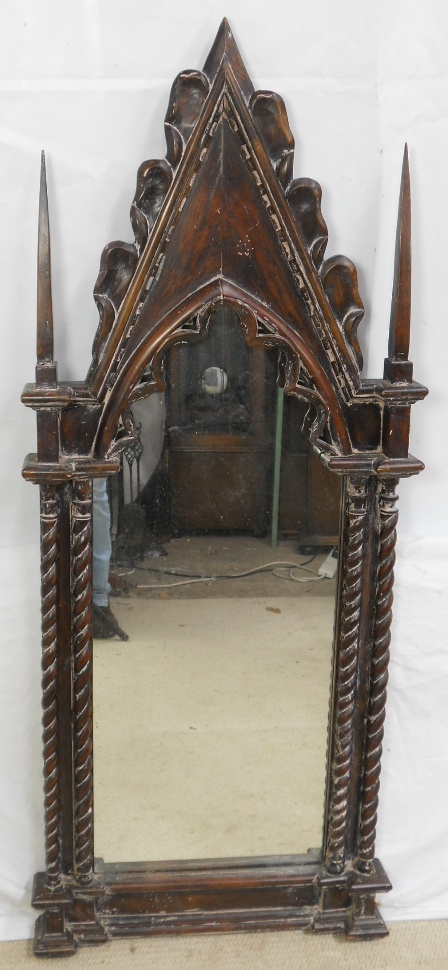You are currently browsing the tag archive for the ‘Gothic’ tag.

Our Inktober special feature of Halloween-adjacent pen-and-ink drawings continues with this enigmatic golden orchid monastery piece which I drew with colored inks on yellow paper.
Lately I have been drawing a series of intricate altarpiece-style compositions after the style of Medieval illuminators (whose seminal contributions to art, culture, and media have been underappreciated because of the post-Vasari cult of celebrity). Hopefully writing about these illustrations in these posts will help contextualize the themes I am trying to highlight.
Here is a little monastic microcosm of the world. In one monastery, a white-haired abbot lords it over his little flower novices. In a sister monastery, the mother superior and her votaries carefully send out an intimate message to the monks by means of technology. Sundry lizard people, extinct animals, and cloaked figures roam about in the space between the two houses as a rain of yellow orchid blossoms falls down from the heavens.
To my mind, the most important part of this composition is the tiny strip of nature in the foreground–a little ecosystem of weeds, wildflowers, seeds, nemotodes, myriapods, and maggots (who are furiously breaking down a mouse skull). The human world of sly courtships, status posturing, and religious grandstanding grows up out of this substrate and pretends to be superior to it (while actually being entirely dependent on the microscopic cycles of life). All of the pompous & made-up things which humankind uses to dress up our savage primate drives do not change the fact that ecosystems are of paramount importance.
The religions of Abraham (among others) put animals and the natural world at the bottom of their moral hierarchy. I believe they are ultimately doomed because of this stupid outlook. Whether they will take us all to a garbage-strewn grave with them remains an open question.
I guess we have been in society-wide quarantine lockdown for an entire year (at least here in New York City). The grim anniversary at least provides the opportunity to show you the artwork which I made during the spring of 2020 as nature burst into glorious life while humankind cowered at home in the shadow of the crowned plague.
I like to draw in little 3.5 inch by 5.5 inch moleskine sketchbooks (which i fill up pretty regularly). Last spring, due to an ordering error, I purchased a Japanese album (which folds out into one long accordion strip of paper) instead of my usual folio book. Since the pandemic left me stuck in my little Brooklyn garden, I began drawing a Coronavirus journey along a continuous garden path running from my backyard, through the stricken city, to the cemetery and then out to the sea. As spring turned into summer I rode my bike over to Greenwood to work on it. Usually works of this sort are destroyed by giant ink blots, spills, or catastrophic drawing failures (since I drew this freehand with a Hiro Leonardt 41 steel nib), and although there are lots of flaws (sigh), none of them destroyed the drawing outright.






as you can see, the one factor which made the isolation and anxiety of the coronavirus pandemic bearable to me was the one thing which makes existence bearable–the unlimited power of imagination to go anywhere and make anything happen! Thus we see a Byzantine/Gothic Brooklyn as suited to the plague of Justinian as to Covid 19.
I effectively finished the drawing in June, but I kept frittering at the edges. Plus there was an empty space in the path beneath the fountain (just before the musical garden filled with lyrebirds, siamangs, singing sphinxes, and aulos players). That space stayed blank until November, when I realized that the blank spot in the middle was where the vaccine belonged (you can see it there now just below the fountain).
Unfortunately, I am a better draftsman than a photographer, and it is hard to make out the small details of the little garden plants and bugs which were my original inspiration. Anyway, hopefully you can click on the panels and look at the musicians (C-minor), the plague doctor, the manticore, and the covid party filled with Bushwick Bohemians and sinners! If not, let me know and we will see if I can repost the drawing somehow. Maybe I will post some of the details later on anyway, since the virus pathway is filled with serpents, bats, dark gods, pigeons, bees, trees, and flounder (and other ferrebeekeeper subjects which are always close to my heart).
Speaking of things close to my heart, thanks again for reading this and for being here with me (at least in my writings and thoughts if not in the real world). Dear Reader, you are the absolute best. If the Fates are willing, we are nearing the end of this horrid covid chapter (just as the dark path from the drawing ultimately runs out into the great ocean and vanishes in the waves). I am sorry it took so long to post this little book, but it seems appropriate somehow. As always, let me know what you think, and for my part I will think about what delights to put in the spring album for 2021!
Health and peace to you and your loved ones! We are nearly through this!

As we move closer to Halloween, it is time to present some more beautiful Gothic imagery…but there is a problem. Ferrebeekeeper has already featured posts about Gothic clocks, gates, gazebos, houses, gingerbread houses, beds, mirrors, Christmas trees, literature, fonts and, uh Goths. What is left?
The great Gothic churches and cathedrals of yesteryear were built in an age before elaborate & inexpensive steel work. While it is easy to understand how stone columns, tall stone arches, and flying buttresses could be used to give height to the great cathedrals of the middle ages, what is harder to grasp is how these huge halls had ceilings! Timber has certain limits of size & strength. Stone, though strong, is heavy! How did the great architects of medieval Europe surmount these limitations so that they didn’t have to pray in the rain?

The answer is that they designed elaborate and beautiful rib vaults. These structures utilized crossed or diagonal arched “ribs” of stone as a supporting framework for thin stone ceiling panels. The results are as stunning as the outside of the cathedrals–but in a more functional way.





To show what I mean, here is a gallery of famous Gothic vaults. Some are plain whereas others are complex. A few are even ornamented (although the ceilings seem to have been left less encrusted with statues, paintings, and mosaics than other parts of the cathedral because they were a weak point and they needed to be functional. The beauty of these structures is thus more like the beauty of diatoms and less like the beauty of the Sistine Chapel Ceiling…although…come to think of it…

There are whole architectural treatises detailing the fans, crosses, liernes, groins, stars, and domes of such cathedrals (and all of the ways they can be combined) but for now let’s just savor the beauty and artistry of stone made into sky.


Orvieto
In the center of Italy is Umbria, a green land of deep forests and medieval hill towns. One of the most dramatic of these hill towns is the small city of Orvieto which is located atop a volcanic plug of tuff. Atop the taupe butte, the ancient towers and campaniles of Orvietto rise above the dark green hills. One building stands out beyond the others, the Duomo di Orvieto which is universally acclaimed for having the consummate masterpiece of Italian Gothic cathedral facades.

Dedicated to the Assumption of the Virgin, the Cathedral of Orvieto was commissioned by Pope Urban IV sometime around 1263 as a suitable place to keep the Corporal of Bolsena, a miraculous uhhh cloth which soaked up the miraculous blood of Jesus which spouted out of a miraculous host (the sacred bread) in the nearby town of Bolsena. The Cathedral was begun in earnest in 1290 as a classic Romanesque basilica, however progress was fitful. When Giovanni di Uguccione succeeded Fra Bevignate as principal architect (project manager?) of the cathedral, the design morphed from Romanesqe to Italian Gothic. It was an inspired upgrade which incorporated the best of both styles in the breathtaking facade (which is said to have been the creation of the Sienese sculptor and architect Lorenzo Maitani).

Creation of Eve (probably by Maitani)
The Facade is such a masterpiece, with so many things going on, that it is nearly impossible to describe properly. Wikipedia resolutely approaches the task by breaking down the individual elements as follows:
The most exciting and eye-catching part is its golden frontage, which is decorated by large bas-reliefs and statues with the symbols (Angel, Ox, Lion, Eagle) of the Evangelists created by Maitani and collaborators (between 1325 and 1330) standing on the cornice above the sculptured panels on the piers. In 1352 Matteo di Ugolino da Bologna added the bronze Lamb of God above the central gable and the bronze statue of Saint Michael on top of the gable of the left entrance.
The bas-reliefs on the piers depict biblical stories from the Old and New Testament. They are considered among the most famous of all 14th-century sculpture. These marbles from the fourteenth and fifteenth century are the collective and anonymous work of at least three or four masters with assistance of their workshops, It is assumed that Maitani must have worked on the reliefs on the first pier from the left, as work on the reliefs began before 1310.
The glittering mosaics of Mary’s life which make up such an impressive part of the facade have been redesigned and replaced since the originals were installed in 1390. However the great central rose window is an original by Orcagna. The widow is surrounded by statues of Apostles within niches in the manner of French Gothic style.

Naturally I was unable to find any high-resolution photos that really do justice to this supremely complicated book of a building, but here is a link to a clickable high resolution image if you want to examine particular individual elements.

Actually the interior of the church might really be the feature of greatest interest to artists, featuring exquisite murals by Fra Angelico and crazy violent “Antichrist” mural by Luca Signorelli, but we will address those another day. How much apocalyptic stuff can we handle right now? Let’s just enjoy the exquisite outside of this Italian Gothic wonder.

Orvieto medieval town, Umbria, Italy, Europe.

Here is an illuminated page of the Grimani Breviary (which is named after a Venetian cardinal who purchased it in 1520 for 500 gold ducates). The breviary takes the form of a calendar and here is the page for April, which features a party of nobles out in the spring countryside falconing. The work is filled with infinitesimal details, but my favorite parts are the capering jester (who has somehow become entangled with a tree as he brandishes his grotesque marotte) and the opulent yet ethereal carriage of Time which, unseen, flies above the procession. The work was completed sometime around 1510 in Flanders. Note also the Crakow shoes worn by the foppish noble in shimmering green and scarlet at the right.

Virgin and Child Enthroned, with Prophets (Cimabue, ca. 1290-1300), tempera on wood
Cimabue was the link between Byzantine art and the art of the Renaissance. His use of shaded form and realistic proportion would lead to a sweeping revolution in painting, yet his work maintains the stolid architectural grandeur (and sloe-eyed otherworldliness) of art from the eastern empire. According to Vasari, Cimabue was Giotto’s master, and although scholars have disputed it based on enigmatic sentences in ancient documents, artists accept it as truth because there is so much of Cimabue in Giotto’s works. This painting originally hung in the Vallombrosians church of Santa Trinita in Florence (Cimabue was a Florentine).
Although the Madonna and Roman-philosopher-attired Baby Jesus (and their bevy of dusky angels with ultramarine/scarlet wings) are quite grand, my favorite part of the composition is the giant strange ivory throne they are seated upon and the Old Testament prophets arrayed along the bottom. From left to right these are Jeremiah, Abraham, David (see his little crown), and Isaiah. They are reading and writing in phylacteries and the two prophet prophets, Jeremiah and Isaiah are looking up at the messiah, a sight they never beheld, yet beheld before all others.

We are nearing the darkest time of the year, and I wanted to post some Gothic architecture all lit up with festive lights, but, though I searched and searched, the Gothic Revival mansions of my fantasy just weren’t out there on the internet. There were some actual Gothic cathedrals from the middle ages which were all lit up with lasers though! Here is a little holiday gallery. We’ll see if we can scrape up some better content tomorrow (and let me know if you find a site with Gothic cottages all lit up for Christmas). Oh! If it Christmas-themed Gothic architecture you need you could always go back in time and check out this Gothic gingerbread post from yesteryear’s Yuletide!










Lydia Ordering the Death of Her Sons (Loyset Liédet and Pol Fruit, ca. 1467–72), Tempera colors and gold leaf on parchment,
Let’s take a break from parade floats, summer flowers, and ice cream artwork to renew our appreciation of all things Gothic. Today’s post involves taking a step back in time to check out the footwear of yore–namely those astonishing pointy Gothic shoes which you see in medieval illumination (like the horrifying Game Of Thrones-ish painting above). Those shoes don’t just exist in ancient artworks and period dramas, specialty cobblers still make them. Here are some photos of Gothic-style footwear which you can buy right now online!

Long-toe Suede Poulaines from armstreet.com





I like all of those, but that green pair is particularly splendid! I would totally wear those if I was accepted into Hogwarts or dragged into a time portal. But what is the story with those toes? Why did lordly fops of the 12th-15th century wear these extreme pointy elvish-looking shoes? The fashion spread throughout northwest Europe, but it originated in Poland (which was going through a sort of golden age) which is why such shoes are called are called “Poulaines” or “Crakows.” The toes were originally filled with moss or other pre-industrial packing materials in order to hold their shape. As the toes became more elaborate and more curved, architectural internal elements made of cork or leather became necessary so they would hold their shape.

I wish I could tell you some satisfying tale of how the pointy toes poked venomous snakes out of the way or helped lords walk on tippy-toe over muddy peasants or something, however, the reason footwear looked as it did then, was much the same as now: namely impractical shoes betokened status. A vast pan-European network of conspicuous consumption existed in the high middle ages and it was a big part of how the elites “kept score.”

So Crakows with their long poulain toes were apparently the Manolo Blahniks of their day. I will keep looking for more to the story, but it seems like this might be a classic case of the things we do for fashion. Don’t worry though, we are not done with Gothic shoes: there is more to come from eras much more recent and familiar. Just stay tuned to Ferrebeekeeper and keep on your toes!


It has been a while since we had a post celebrating all things Gothic. Last week’s post about the Yellow Emperor has reminded me of the unsettling relationship which we all have with mirrors (which are so lifelife and yet so empty and which always feature our own aging countenances staring at us with mute appeal). I wondered if I could find some beautiful ornamental Gothic mirrors to put up in a little gallery. Boy howdy! There were a lot to chose from. Here is a little sampling:









Of course these mirrors have the beauty of Gothic style, but they lack the disturbing simulacra of life which real mirrors furnish. You will have to imagine your own face in them. Or you could head over to your nearest foreboding manor to see if you can find one of these beauties underneath a big gray dusty sheet. Or I guess you just buy them: they are mostly for sale on the internet, which is maybe the most disturbing thing of all….

Here is an illuminated page from the Da Costa Book of Hours which was illustrated by Flemish master Simon Bening around 1515 AD. Bening was regarded as the last great Flemish illuminator. His illustrations (somewhat like “The Shepheardes Calender“) chart the months of the year through sensitive landscapes filled with hard-working farmers and gardeners. It is a remarkable and rare work in the canon or art in that the workers look like they are actually working, but are neither bumpkinish figures of fun nor beautiful superhumans (although they are brilliantly attired in expensive new garb). The book was made for the Sá family of Portugal (it is a Sephardic surname). This is the illustration for the month of March when winter has not yet left the land, yet the first green shoots are appearing. The gardeners are hard at work laying in the new garden and repairing the trellised avenue as a fur clad nobleman explains what he wants. Note the courtly nobles holding hands on the bridge and the stork nesting on the chimney of the handsome little gothic chateau.

